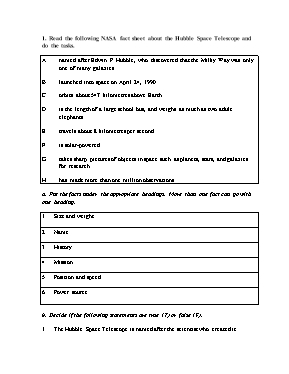Bài tập Unit 10 môn Tiếng Anh Lớp 9 - Phần đọc
Bạn đang xem tài liệu "Bài tập Unit 10 môn Tiếng Anh Lớp 9 - Phần đọc", để tải tài liệu gốc về máy bạn click vào nút DOWNLOAD ở trên

1. Read the following NASA fact sheet about the Hubble Space Telescope and do the tasks. A named after Edwin P. Hubble, who discovered that the Milky Way was only one of many galaxies B launched into space on April 24, 1990 C orbits about 547 kilometres above Earth D is the length of a large school bus, and weighs as much as two adult elephants E travels about 8 kilometres per second F is solar-powered G takes sharp pictures of objects in space such as planets, stars, and galaxies for research H has made more than one million observations a. Put the facts under the appropriate headings. More than one fact can go with one heading. 1. Size and weight 2. Name 3. History 4. Mission 5. Position and speed 6. Power source b. Decide if the following statements are true (T) or false (F). 1. The Hubble Space Telescope is named after the scientist who created it 2. The telescope moves in space around the earth. 3. It is as heavy as one elephant. 4. Its speed is about 480 kilometres per minute. 5. The telescope uses wind energy for its operation. 6. Its mission is to take pictures of the universe for scientific research 2. Read the text and choose the best answers. Earth, our beautiful home planet, is the only astronomical object to accommodate life as we know it. Scientists believe Earth was formed approximately 4.5 billion years ago. It is the fifth-largest planet in our solar system. Its equatorial diameter is about 12,074 kilometres. Earth is the third-closest planet to the sun. The distance from Earth to the sun is roughly 149,600,000 kilometres. It takes 365.3 days for Earth to orbit the sun, and 24 hours to rotate on its axis. The surface temperature ranges from -88 to 58°c. Nearly 70 percent of Earth's surface is covered by ocean, which has an average depth of about 4 kilometres. In 2015 it was estimated that 7.3 billion humans are living on Earth. 1. As we know it, Earth is the only planet that accommodates life. It is_____. A. habitable B. habitual C. habitat 2. There are_____ planets between Earth and the sun. A. two B. three C. four 3. In our solar system,_____ planets are larger than Earth. A. two B. three C. four 4. The hottest place on Earth may have the temperature of _____. A. -88°c B. 58°c C.40°c 5. It takes_____ for Earth to rotate on its axis. A. one year B. one month C. one day 6. Most of Earth's surface is covered by_____. A. ocean B. mountain C. forest 3. Read the text and do the activities that follow. Did you know that the spacesuit astronauts wear while in outer space is formally called an Extravehicular Mobility Unit, or EMU? ‘Extravehicular’ means outside of a spacecraft, and (1) ‘____________’ means that the astronaut can move around in the suit, independent of the (2) ____________. An EMU is not simply a set of clothes. The suit provides life support, and environmental protection for the astronaut during planetary exploration or (3) ____________. For example, spacesuits protect astronauts from extreme temperature change, which can go as cold as (4) ____________ or as hot as 120 degrees Celsius. Spacesuits also supply astronauts with (5) ____________to breathe and water to drink during spacewalks. They protect astronauts against fast-moving space dust particles, (6) ___________, and bright sunlight. a. Put the following words/phrases in the appropriate gaps in the text. spacewalks-radiation-mobility-oxygen-spacecraft-minus 150 degrees Celsius b. Answer the questions. 1. What does EMU stand for? 2. Why is an EMU spacesuit more than a set of clothes? 3. When do astronauts wear an EMU? 4 Give one example of how an EMU provides astronauts with environmental protection. 5 Give one example of how an EMU provides life support for astronauts.
Tài liệu đính kèm:
 bai_tap_unit_10_mon_tieng_anh_lop_9_phan_doc.doc
bai_tap_unit_10_mon_tieng_anh_lop_9_phan_doc.doc





